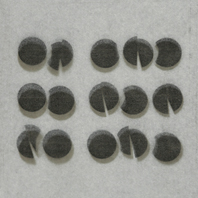: decibel

Decibel, Disintegration: Mutation
hellosquare recordings, CD, cube046
http://hellosquare.bandcamp.com/
In their manifesto, Decibel state that they “seek to dissolve any division between sound art, installation and music.” Their CD Disintegration: Mutation represents more than just sound. To appreciate it fully, you must read the liner notes, visit their webpage and preferably see a performance either on YouTube or, ideally, live.
Decibel blend acoustic instruments (strings, woodwinds) with electronics (keyboards, turntables, Max MSP processing and networking) and you can watch their scrolling graphic scores online, adding a significant dimension to the appreciation of the music. I’ve not seen them live, but it’s clear that Decibel performances are dramatic presentations and the abstract sounds are given degrees of meaning or emphasis depending on the depth of the listener’s engagement.
Track 1 is Decibel founder Cat Hope’s composition “In the Cut,” for cello, bass clarinet, bass guitar and a turntable playing a specially made recording of a descending tone. “In the Cut” uses pitch, texture and timbre to chilling effect. Inspired by the eponymous Susanna Moore novel (which became a Jane Campion film), it starts with a squealing violin note that’s joined by cello and clarinet. The pitches slowly fall, the instruments eventually detune and the sound becomes chaotic, suggesting entropic decay, as if music itself is collapsing. Behind the arrhythmic, sinking line is a low, droning, all-consuming rumble. Music like this is best heard on a PA at high volume to add visceral impact.
Track 2, Hope’s “Kuklinski’s Dream,” begins with an ethereal, breathy whisper that segues into the more strident and densely woven timbres of bass clarinet and strings that echo and mock the eerie whispering sound. The dreaminess of the high-pitched opening becomes nightmarish when we discover that the sound source is the bowing of knife blades, referencing the murder-weapon of late Mafia hitman Richard Kuklinski, after whom the work is named. The sight of the bow hairs being shredded in live performance would add a macabre visual element—a musical instrument that self-annihilates. The graphic score is based on fragments of Kuklinski’s signature so that the work, for three carving knives, bass clarinet, double bass, cello and processing, directly embodies his persona as well as his apparatus. Whereas “In the Cut” represented entropy through pitch and distortion, “Kuklinski’s Dream” represents murder.
Lindsay Vickery’s “Transit of Venus” is a gently developing progression of tones and timbres involving live processing and performer-specific click tracks that, together with the graphic score, guide the pitch, dynamics, textures and time periods. Hope’s double bass creates a bubbling sensation that sits below the fluttering violin and pizzicato cello, and each instrumental voice ebbs and flows intriguingly as the work unfolds. The final work is Vickery’s “Antibody,” which was evidently inspired by biological mutation, and in which Malcolm Riddoch’s organic looking online visual representation maps the harmonics graphically, showing how they grow outward from the central tone. The same visual representation could be made for any sonic event, but it seems essential to the concept for this work. The sound is a densely layered haze of momentary gestures and structural threads, and the cello line is especially interesting. The longest track at 14 minutes, for alto flute, bass clarinet, violin, cello, keyboard and processor, it has an engagingly quizzical musicality.
Whereas Decibel has previously foregrounded works by other composers, this CD comprises compositions by its members demonstrating their manifesto. Hope’s compositions contrast with Vickery’s in the nature of the inspiration for the work. Hers have great psychological and theatrical impact, while the lush complexity of his suggests a more conventional musicality, as you focus on the timbres, textures, resonances and formal development. Both composers continue the interrogation of sound in space and the possibilities for the generation and realisation of sound, though the CD format unfortunately restricts spatial awareness. They also mix improvisation with graphic scores, programmed electronics and click tracks, making for a highly complex set of performance parameters, though these are undetectable when listening to the CD, as is any aleatoric variability from performance to performance.
Disintegration: Mutation is absorbing and resolved work that extends the aesthetic that has emerged over recent years in blending the sonically possible into the demandingly-but-satisfyingly musical. The CD’s title suggests Decibel’s approach —the disintegration of conventional music and the mutation of sound into new forms.
Chris Reid
http://decibel.waapamusic.com/
See also Darren Jorgensen’s review of Decibel’s performance of Alvin Lucier’s work in RT97; Jonathon Marshall’s review of Decibel’s Tape It! performance in RT94; and download a sample from RealTime’s SoundCapsule #1.






